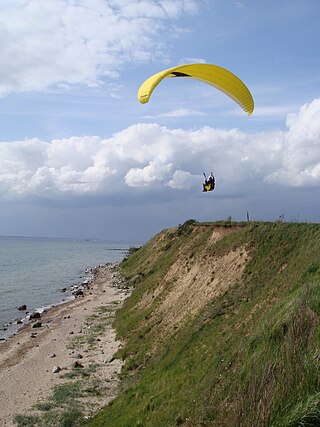
The Advance Omega is a series of Swiss single-place, paragliders, designed and produced by Advance Thun of Thun.
The Aerodyne Jumbe is a series of French single-place and two-place, paragliders that was designed by Michel Le Blanc and produced by Aerodyne Technologies of Talloires.
The Apco Keara is an Israeli single-place, paraglider that was designed and produced by Apco Aviation of Caesarea. It is now out of production.
The Apco Presta is an Israeli single-place, paraglider that was designed and produced by Apco Aviation of Caesarea. It is now out of production.
The Apco Prima is an Israeli single-place, paraglider that was designed and produced by Apco Aviation of Caesarea. It has been in production since the early 1990s and remained in production through 2016.
The Apco Simba is an Israeli single-place, paraglider that was designed and produced by Apco Aviation of Caesarea. It is now out of production.
The Gradient Bliss is a Czech single-place, paraglider designed and produced by Gradient sro of Prague. Originally produced in the mid-2000, it is no longer in production.
The Mac Eden is a Czech single-place paraglider that was designed by Peter Recek and is produced by Mac Para Technology of Rožnov pod Radhoštěm. It remains in production in 2016 as the Eden 6.
The Nova Aeron is an Austrian single-place paraglider that was designed by Hannes Papesch and produced by Nova Performance Paragliders of Innsbruck. It is now out of production.
The Nova Artax is an Austrian single-place paraglider that was designed by Hannes Papesch and produced by Nova Performance Paragliders of Innsbruck. It is now out of production.
The Nova Pheron is an Austrian single-place paraglider that was designed by Hannes Papesch and produced by Nova Performance Paragliders of Innsbruck. It is now out of production.
The Nova Phorus is an Austrian single-place paraglider that was designed by Hannes Papesch and produced by Nova Performance Paragliders of Innsbruck. It is now out of production.
The Nova Radon is an Austrian single-place paraglider that was designed by Hannes Papesch and produced by Nova Performance Paragliders of Innsbruck. It is now out of production.
The Ozone Proton is a French single-place paraglider that was designed by hang gliding and paragliding world champion pilot Robbie Whittall and produced by Ozone Gliders of Le Bar-sur-Loup. It is no longer in production.
The Sky Flare is a Czech single-place paraglider, designed and produced by Sky Paragliders of Frýdlant nad Ostravicí.
The Sol Prymus is a Brazilian single-place paraglider that was designed and produced by Sol Paragliders of Jaraguá do Sul starting in the mid-2000s. It remained in production as the Prymus 4 in 2016.

The Swing Arcus is a series of German single-place and two-place paragliders, designed and produced by Swing Flugsportgeräte of Landsberied. In 2016 it remained in production as the Arcus 7.
The Mistral is German single-place paraglider that was designed and produced by Swing Flugsportgeräte of Landsberied. It is now out of production.
The UP Makalu is a German single-place paraglider that was designed and produced by UP Europe of Kochel am See. Introduced in 2001, production of the final version ended in 2020.

The Windtech Quarx is a Spanish single-place paraglider that was designed and produced by Windtech Parapentes of Gijón. It is now out of production.



